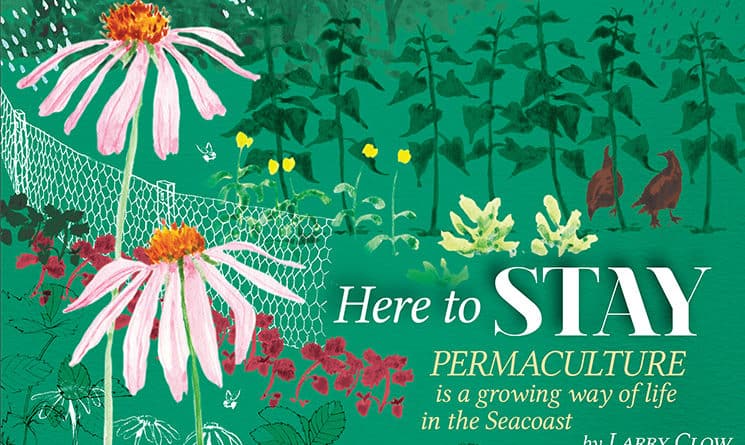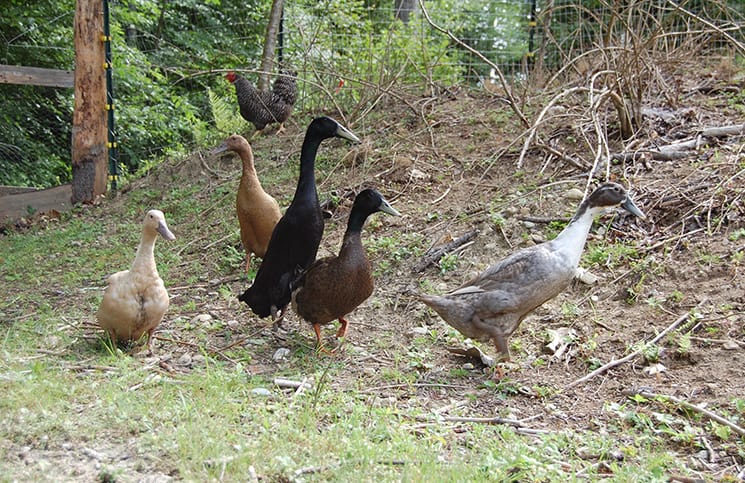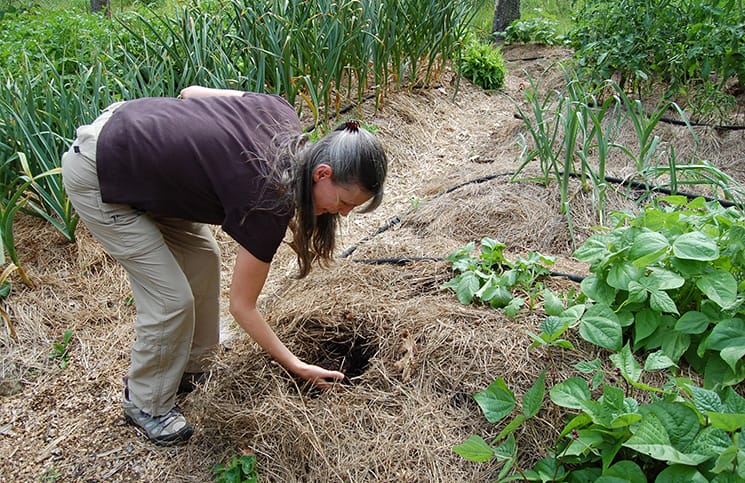Permaculture is a growing way of life in the Seacoast
by Larry Clow, photos and artwork by Alyssa Grenning
People like to ask Leslie Stevens how to grow things. You can’t blame them — stroll past her house in a quiet residential neighborhood less than a mile away from downtown Portsmouth and you’ll see a yard bursting with plants. Cucumbers, blueberries, strawberries, onions, garlic, and others, all growing just off the sidewalk. When Stevens is tending to the plants, strangers inevitably come up and ask questions.
“A woman rode up on her bike and had a potato in her hand … and she came up and asked me, ‘Can you tell me how to grow this?’” Stevens says. And then there was the man who walked by and handed her some “magic beans.” “Can you plant them and see what grows?” he asked her. So she did — they were an Italian variety of bean, not magical at all.
“He didn’t come back,” Stevens says.
And this is just in Stevens’ front yard. She’s got a fifth of an acre to work with, and in the back yard are tomatoes, cucumbers, flower beds, a herb garden, chickens, compost bins, rain barrels, a pair of fig trees (named Phineas and Fiona), and more. Stevens calls it Sidewalk Farms. She grows enough here, and at Goss Farm in Rye (as well as small gardens at the Children’s Museum of New Hampshire in Dover and the Urban Forestry Center in Portsmouth), to feed her family and sell food at the Rye farmers market.
“It’s rare that we’ll eat a meal that doesn’t have something that was grown here,” she says.
Stevens is an organic farmer, a master gardener, and a part of the Seacoast’s growing permaculture community. Permaculture is a system of agricultural and social principles all aimed at using sustainable and natural methods to solve problems. It’s something humans have been doing for generations, but the term, and the philosophies behind it, were developed in the late 1970s in Australia by David Holmgren and Bill Mollison.
In the last four decades, permaculture has crept slowly into the mainstream. Here in the Seacoast, that growth is reflected in the Greater Seacoast Permaculture Group, a loose collection of permaculture practitioners, budding students, and curious onlookers. The group boasts some 800 members on its Meetup.com page, though there are no official membership requirements. Members like Stevens host workshops, tours, book groups, and other educational programs on everything from raising goats and keeping bees to swapping plants and building garden beds.
“Five years ago, permaculture was new. People didn’t know about it,” Stevens says. “But I think people realize that change is inevitable in all our systems … and people realize they need to change themselves. That’s increased a lot in the last five years, and the amount of information is increasing as well.”
Solving problems
When Holmgren and Mollison created the term “permaculture” in the ’70s, it initially stood for “permanent agriculture.” The definition has shifted slightly, according to Amy Antonucci, a permaculturist who lives in Barrington. Now, it’s more focused on “permanent culture,” as practitioners look beyond growing food sustainably to other problems — renewable energy, landscape and building design, reusing resources, and self-sufficiency, among others.
“Really, it’s a system for solving problems. Anything can be addressed through permaculture,” she says.
When it comes to the areas on which permaculture focuses, there is no shortage of problems, from reducing dependency on fossil fuels and mitigating the effects of climate change to establishing sustainable food systems and making communities more self-reliant.
Antonucci and her husband, Steve Diamond, bought their house and seven acres of land about six years ago. Built on a slope with little soil, lots of rocks, and a thick tangle of brush and trees, “no farmer would’ve looked twice at it,” Antonucci says. “But, as a permaculturalist, I could see potential.”
Antonucci began studying permaculture 15 years ago. A Northeast Organic Farming Association conference tipped her off to permaculture classes. She started reading and completed a two-week intensive permaculture design course. And then she kept going — taking more classes, touring sites, talking with other permaculturists, and, most importantly, experimenting at home.
“Fifteen years ago, there were three permaculture sites in New Hampshire and I drove around to them all. Now there are a lot more, and they’re all offering tours,” she says.
“The idea is to get out of nature’s way and let natural processes happen.”
— Amy Antonucci
That may one day be the case in Barrington. She and Diamond have transformed their home into a permaculture showcase. A steep hill runs from the road to the house; on the hill, Antonucci has built a series of swales and berms — basically, small trenches and barriers — to collect water runoff from the road and prevent soil erosion. The collected water feeds a small grove of fruit trees and bushes: elderberry, peach, persimmon, blueberry, and the like. The frogs in a nearby irrigation pond keep the slugs at bay; so do the flock of ducks that roam the property.
“The idea is to get out of nature’s way and let natural processes happen,” Antonucci says.
The ducks also help fertilize the soil and provide eggs; so do the chickens. Goats Cocoa and Juniper eat brush and weeds and also act as a food source. Antonucci’s bees keep the plants in the garden pollinated. The garden is surrounded by a wire fence — the fencing itself was salvaged, and the six-foot-tall posts are actually the remains of trees that she and Diamond have been slowly clearing to make room for the garden, the animals, and everything else. In the garden, she’s working on building up top soil.
“Building soil is one of the most important things to me. It’s the legacy I’m leaving. If I die and I can say I built up a foot of soil here, then I’ll be happy,” she says.
Growing together
Permaculture’s three principles are “earth care, people care, and fair share,” according to Antonucci, who also teaches a variety of permaculture classes. Part of those principles means sharing what you’ve learned with others.
That’s one of the missions of the Newmarket Community Garden. Maggie Schier has been running the garden for six of its nine seasons. Located off Dame Road, just outside of downtown, about 50 gardeners tend to 33 plots. A $25 a year rental fee gives gardeners access to water from rain barrels, compost from Pinewood Yankee Farm in Lee, and a shed full of tools.
“It’s ever changing because Newmarket is ever changing. It’s a great trial run for people interested in learning about gardening,” Schier says. “Community gardens are about getting people together and learning as a group.”



